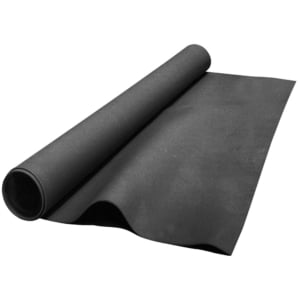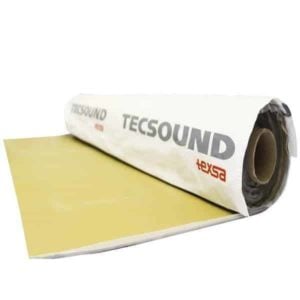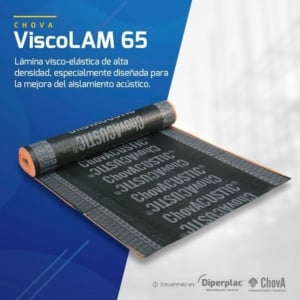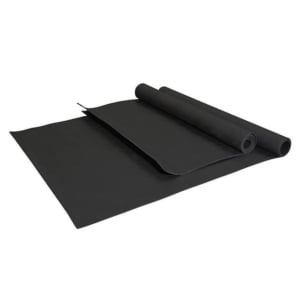Mass loaded vinyl, or MLV, also known as limp mass, is a heavy, limp vinyl sheeting material that usually has been impregnated with metal particles to increase its mass. Mass loaded vinyl is used for adding mass to walls and ceilings as part of a soundproofing or sound control scheme.
Due to its flexible nature, this high-density soundproofing material is also non-resonant, dampening vibration caused by sound energy to ensure noise reduction.
Often mass loaded vinyl is sandwiched between sheets of other material, such as between two layers of drywall, to create wall and ceiling covering. In some cases, mass loaded vinyl is denser (heavier per square foot) than sheet lead. A great example of mass loaded vinyl is Nankarrow Isobrane & Texsa Tecsound. Other brands we stock are Danosa, Sound Bloc, and Armasound.
Mass Loaded Vinyl (MLV) is both tough and effective. A greener, more viable alternative to lead soundproofing, MLV barriers are composed of salts, sands and tiny metal particles that give it sound reducing properties similar to old lead sheeting, but without the stigma associated with Lead based materials.
The goal of MLV soundproofing is to add dense mass to an enclosed area so that sound waves are blocked from passing through ceilings and walls. In fact, you’ll find MLV soundproofing material in music studios serious about quality sound control.
Detailed Information
The material is comprised of two principle ingredients: vinyl — to give the MLV flexibility, “the limpness” and, a naturally occurring, high mass element. Often Barium Sulfate is used due to its unique properties – it is non-toxic and has a high relative density. This latter attribute of high density is what makes Mass Loaded Vinyl so effective in blocking sound.
What’s the difference between Mass Loaded Vinyl and Rockwool/Glasswool?
We first need to understand what makes a good absorber or barrier. In general there are only two characteristics that make an effective sound absorber or sound barrier – “fuzzy stuff” (mineral fibre or fiberglass) or mass. Most if not all absorbers and barriers have one or both of these characteristics in their design. How these materials are employed in the design of the absorber / barrier or, how and where the absorber / barriers are placed in an environment is the wizardry of acoustic design.
Absorbing sound relies heavily on the knowledge and manipulation of a sounds wavelength. For example, mid to high-frequency sound — say above 500 Hz — have wavelengths greater than 68 cm in length (˜ 27 inches). To absorb this wavelength with fuzzy stuff would require a minimum depth of absorber of one-quarter of the waves length. In this example, 17 cm (˜ 6 inches) of depth would be needed to attenuate frequencies at and above 500 Hz.
Fuzzy stuff absorbers function by virtue of the fuzzy materials porosity (the percentage of pores or crevices, to the total volume of the mass). These crevices capture the relatively short wavelengths of mid to high-frequency sound and convert the sounds energy to heat via friction.
Blocking sound on the other hand, requires that the material to be used be the opposite in composition to an absorber. The material needs to be dense. Density is derived from mass. Highly dense or massive materials typically do not have a porous structure to allow the sound wave to enter (and pass through) them. Consequently, any material that has a high mass could be used to block a sounds path. Concrete, gypsum board, MDF, hardboard and concrete masonry units are all popular examples of high mass barriers. The problem with these common building materials is that they are very stiff. They have great mass but they don’t get the overall sound reductions you would expect from them because they are not limp and flexible like the mass loaded vinyl (MLV). Again it is the application of the mass (the what, where and how the mass is used) that will make an effective sound barrier.
Why is Mass Loaded Vinyl so popular as a technical sound barrier?
Because MLV has a very small cross-section, it’s flexible AND it’s massive!
None of the earlier examples of high mass barriers can be wrapped around or molded to the shape of something — MLV can. This unique combination of small dimension, mass and flexibility makes Mass Loaded Vinyl a one-of-a-kind material in the world of sound barriers.
What if we could double the total mass of a given construction project and use only a few millimeters of additional space? This is where Mass Loaded Vinyl is irreplaceable.
Where to use Mass Loaded Vinyl?
- Soundproofing walls
- Soundproofing ceilings
- Soundproofing floors
- Soundproofing pipes
- Soundproofing HVAC ducts
- Soundproofing office partition walls
- Soundproofing computer server rooms
- Soundproofing mechanical rooms




